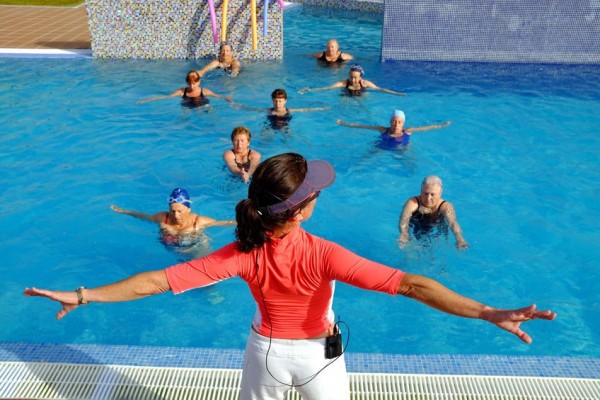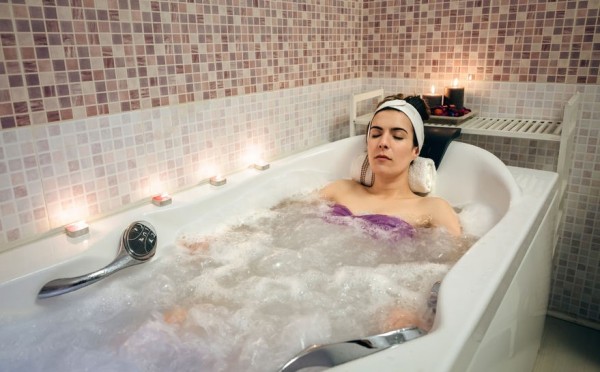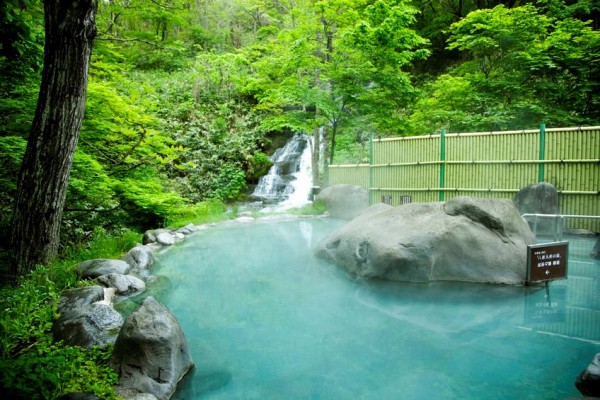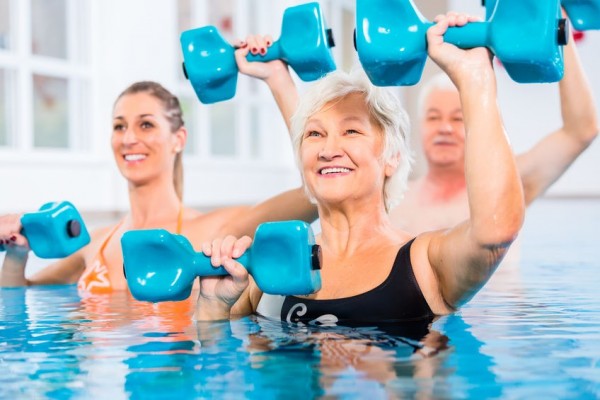Hydrotherapy for Chronic Pain Conditions

Water is used to alter the intensity of an exercise, and due to the buoyancy of the water, it is less stressful on a person's joints and body in general. Treatments may include steam baths, saunas, aquatic exercises, hot/cold compresses, hot/cold showers, and water therapy. There are professional treatments, as well as treatments that can be done from the comfort of your own home.
There is a decreased gravitational force providing less stress and weight on joints such as the knees and hips. Hydrotherapy treatment options can be as simple as floating in water to receive temperature and relaxation benefits, to intense aquatic exercises. Some facilities even have underwater treadmills. Exercises can always be intensified by increasing speed of movement, turbulence, or adding objects to hold while moving in the water. Even individuals who don’t know how to swim can use hydrotherapy treatments. Water can create deeper relaxation for people physically, mentally, and emotionally.
 Just submerging your body waist deep into water, you will experience about 50% less weight. For example, semi-submerged in water, a 176lb person would be working with about 88lb. Then, with chest to neck level immersion your body weight is reduced by 75-90%.
Just submerging your body waist deep into water, you will experience about 50% less weight. For example, semi-submerged in water, a 176lb person would be working with about 88lb. Then, with chest to neck level immersion your body weight is reduced by 75-90%.
One of the many benefits of hydrotherapy is water’s ability to alter blood flow. Cold water stimulates the body by constricting blood vessels and restricting blood flow to slow inflammation (University of New Hampshire). The blood goes away from the surface of the body toward internal organs, allowing them to function more effectively. Hot water relaxes the body by dilating blood vessels, increasing blood flow and sending it to the skin and muscles to ease stiffness (University of New Hampshire). The hot water also activates sweat glands and removes waste from body tissues. Some hydrotherapy sessions involve altering hot and cold water in order to decrease inflammation, strengthen immune system, stimulate circulation, cause lymphatic drainage, boost hormone function, and activate organ function. Temperature plays a very important role in hydrotherapy. With different health conditions treatments will require different water temperatures.
Hydrotherapy can speed up the healing process for example of a broken leg or ankle. Once the cast is removed a person is still unable to place their weight on it. However, in water they can do a variety of exercises without placing weight on it. This will improve circulation in the injured body part which will speed up the healing process. In addition, by doing strengthening exercises range of movement will also be increased helping speed up recovery.
 Joint Range of Motion Increases
Joint Range of Motion Increases Just a hot bath in temperatures over 100 degrees Fahrenheit can help with relaxing tight muscles, relieving sore muscles, and improving arthritis symptoms.
 Steam, Sauna, and Compresses make use of the heat carried through the water. Steam is created when water is heated beyond its boiling point. The steam helps to detoxify the body. Saunas also help to detoxify the body with dry heat reducing stress levels. Compresses are towels soaked in either hot water to promote blood flow and ease stiff and sore muscles, or cold water to reduce inflammation and swelling.
Steam, Sauna, and Compresses make use of the heat carried through the water. Steam is created when water is heated beyond its boiling point. The steam helps to detoxify the body. Saunas also help to detoxify the body with dry heat reducing stress levels. Compresses are towels soaked in either hot water to promote blood flow and ease stiff and sore muscles, or cold water to reduce inflammation and swelling.  Some people visit spas for medical conditions or just to unwind and relax. When it comes to chronic pain many health conditions can benefit from hydrotherapy.
Some people visit spas for medical conditions or just to unwind and relax. When it comes to chronic pain many health conditions can benefit from hydrotherapy.
Airborne infections/diseases, Cardiovascular Disease, Decreased Sensitivity to hot or cold temperatures, Fevers, Heart Disease, Hemorrhage, High Blood Pressure, Inflammation, Kidney Disease, Pregnancy, Uncontrolled Seizures, and Vascular conditions.
It is advised to check with your health care professional if you have any serious health conditions, before trying many of the hydrotherapy treatments.
There is also the possibility for anyone to have an allergic reaction to an essential oil or herb added to bathing water. The best way to avoid an allergic reaction is to test how your skin reacts to the product first. Rub a small amount of the diluted product on your skin and pay attention to redness or irritation. Another serious side effect can be overheating from a sauna, steam room, or hot tub, so make sure there is supervision, when needed. And always drink plenty of fluids. Always check with your health care provider if you are unsure of whether a hydrotherapy treatment is safe for your health condition.
Hippocrates, the father of modern medicine, prescribed bathing in spring water to ward off sicknesses. Hydrotherapy dates as far back as 4500 B.C. according to evidence on an ancient bath unearthed in Pakistan (Encyclopedia.com).
 Hydrotherapy has been used for centuries in the form of bath houses, steam, hot mineral springs, aromatic massages, and spas. Bathhouses were an essential part of ancient Roman culture documenting back to the first century. Roman physicians Galen and Celsus wrote of treating patients with warm and cold baths in order to prevent disease (Encyclopedia.com). Egyptian royalty bathed in oils and Roman baths were popular among citizens. At this time, hydrotherapy was used more as a means of relaxation than to improve illnesses. Public bathhouses didn’t make their way into America until the mid 1700s.
Hydrotherapy has been used for centuries in the form of bath houses, steam, hot mineral springs, aromatic massages, and spas. Bathhouses were an essential part of ancient Roman culture documenting back to the first century. Roman physicians Galen and Celsus wrote of treating patients with warm and cold baths in order to prevent disease (Encyclopedia.com). Egyptian royalty bathed in oils and Roman baths were popular among citizens. At this time, hydrotherapy was used more as a means of relaxation than to improve illnesses. Public bathhouses didn’t make their way into America until the mid 1700s.
It was in the 19th century when hydrotherapy began to form into the therapy that we often see in our society today. Sebastian Kneipp (1821-1897), a Bavarian monk, created many of the hydrotherapy techniques still used today. Kneipp created the hydrotherapy systems after he developed tuberculosis (an incurable disease at the time), and cured himself with water immersion baths and water therapy. He claims that many of his patients were cured from diseases after submerging their bodies into cold rivers 2-3 times in a week (University of New Hampshire). Many of his techniques at the time were administered by doctors for rehabilitation to help with medical treatments. Kneipp opened many hydrotherapy clinics which are still around today. His concept of Contrast Hydrotherapy alternating hot and cold water is still popular today.
Vincenz Priessnitz is also known to be one of the creators of hydrotherapy techniques. He was treating patients with baths, packs, and cold spring water in Austria around the same time as Kneipp. Just in his first year of opening a spa he treated over 1,500 patients. His hydrotherapy techniques paved the way for many physicians and specialists.
Hydrotherapy is a common treatment today to be used by naturopaths. Although it has become a great form of therapy in the modern world, it is barely spoken about or promoted in Northern America. In Europe and Asia, it is popular for people to take advantage of hot mineral springs.
In 2018, a study was published in the Clincial Rehabilitation showing the success of hydrotherapy in the treatment of Osteoarthritis. Researchers compared the effectiveness of twice-weekly individual aquatic exercise sessions to once a week group patient education in 60 people with knee osteoarthritis. Pain and function both improved after the eight weeks for those doing the aquatic therapy.
 Another report showed short-term improvement in pain and quality of life for people with knee/hip osteoarthritis after doing aquatic exercise. This research study was published in the Cochrane Database of Systematic Reviews. It had a total of 1,190 participants.
Another report showed short-term improvement in pain and quality of life for people with knee/hip osteoarthritis after doing aquatic exercise. This research study was published in the Cochrane Database of Systematic Reviews. It had a total of 1,190 participants.
Six studies showed reduced pain, joint tenderness, mood and tension symptoms, and increased grip strength for those suffering from Rheumatoid Arthritis, after receiving short-term hydrotherapy treatments. Most of the studies compared hydrotherapy treatment to receiving no treatment at all. Hydrotherapy was shown to positively help people with rheumatoid arthritis vs. no treatment in the short-term.
In 2017, a report published in the Journal of Strength and Conditioning Research showed the effectiveness of cold water immersion and contrast water therapy for recovery from athletic activities. The study showed benefits in neuromuscular recovery and fatigue 24-hours after team sports.
Based on 10 randomized controlled trials hydrotherapy has shown positive outcomes for helping with the management of fibromyalgia. Pain, health-status, and tender point count showed improvements.
Hydroreference.com has a few other studies showing the success of hydrotherapy for multiple ailments.
So hydrotherapy is an addition to the training and education they already have for their profession. In the U.S. individual workshop courses may take just 15 hours with specialty training taking up to 100 hours or more. At a hydrotherapy school the curriculum covers: history and principles, techniques, equipment used, choosing water temperatures, and physiological effects and medical contraindications (Natural Healers). Hydrotherapists become licensed and certified usually under their profession (naturopath, massage therapist, physical therapist).
So you can find a hydrotherapist by searching for a particular therapist or practitioner. You can also search for "hydrotherapy" or search using the term "aquatic therapy" in your area. A recent study showed that 55% of American spas do offer hydrotherapy options.
The first initial appointment will likely take an hour or more. Aquatic therapy treatment sessions after that, maybe anywhere from 30 – 45 minutes long.
University of New Hampshire/Hydrotherapy. Retrieved from:
https://www.unh.edu/health/ohep/practices/hydrotherapy
Sports Injury Clinic/Hydrotherapy Explained. Retrieved from:
http://www.sportsinjuryclinic.net/treatments-therapies/hydrotherapy
Wong, Cathy. (2018 March 2nd). VeryWellHealth/What is Hydrotherapy. Retrieved from:
https://www.verywellhealth.com/different-types-of-hydrotherapy-89993
Perfect Balance Clinic/History of Hydrotherapy. Retrieved from:
http://www.perfectbalanceclinic.com/blog/injury-and-treatment-advice/history-of-hydrotherapy/
Encyclopedia.com/Hydrotherapy. (2005). Retrieved from:
https://www.encyclopedia.com/medicine/divisions-diagnostics-and-procedures/medicine/hydrotherapy
Natural Healers/Hydrotherapy Training and Careers. Retrieved from:
https://www.naturalhealers.com/hydrotherapy/
Physio.co.uk/Conditions Helped by Hydrotherapy. Retrieved from:
http://www.physio.co.uk/treatments/hydrotherapy/conditions-helped-by-hydrotherapy.php
HEALTHSMART EXERCISE PHYSIOLOGY/Hydrotherapy for Chronic Conditions. Retrieved from:
http://healthsmartep.com.au/hydrotherapy-chronic-disease/
Alternative Medicine Zone/Introduction Hydrotherapy and Types of Hydrotherapy. (2015 May 25th) Retrieved from:
ScratchMommy/What is a Fomentation? (and why you should make them!).
Retrieved from: https://www.scratchmommy.com/stacy-what-is-a-fomentation-and-why-make-one/
Al-Qubaeissy MD, Khamis Y., Fatoye PhD, Francis A., Goodwin PhD, Peter C., Yohannes Phd, MSc, FCCP, Abebaw M. Wiley Online Library/Muskuloskeletal Care: The Effectiveness of Hydrotherapy in the Management of Rheumatoid Arthritis: A Systematic Review. Retrieved from:
https://onlinelibrary.wiley.com/doi/abs/10.1002/msc.1028
Taglietti, Marcelo, Facci, Ligia Maria, Trelha, Celita Salmaso, Cristiane de Melo, Fernanda, Wosiack da Silva, Daniela, Sawczuk, Geovane, Ruivo, Thamires Marques, Barbosa de Souza, Thaisley, Sforza, Chiarella, Cardoso, Jefferson Rosa. (2018, February 8th) SAGE Journals/Clinical Rehabilitation: Effectiveness of aquatic exercises compared to patient-education on health status in individuals with knee osteoarthritis: a randomized controlled trial. Retrieved from:
http://journals.sagepub.com/doi/10.1177/0269215517754240
Procare Physical Therapy/Aquatic Therapy. Retrieved from:
https://procarept.org/aquatic-therapy/
Higgins, Trevor R, Greene, David A., Baker, Michael K. (2015 May 1st) Ovid/Effects of Cold Water Immersion and Contrast Water Therapy for Recovery From Team Sport: A Systematic Review and Meta-analysis. Retrieved from:
https://insights.ovid.com/crossref?an=00124278-201705000-00032